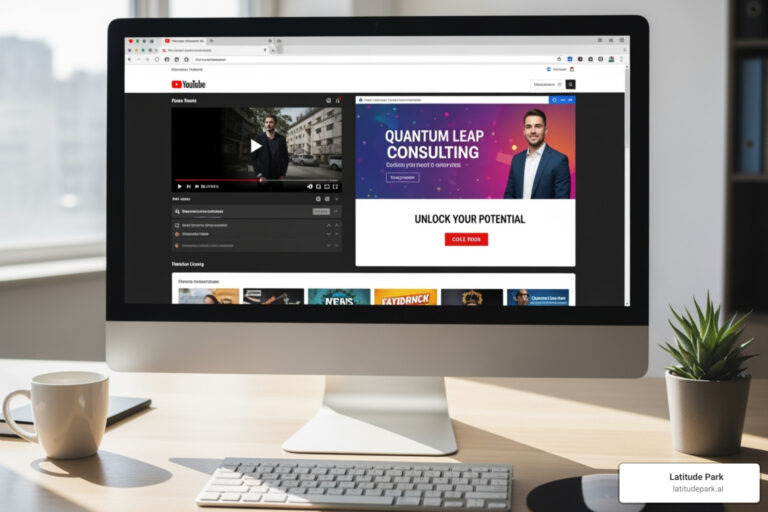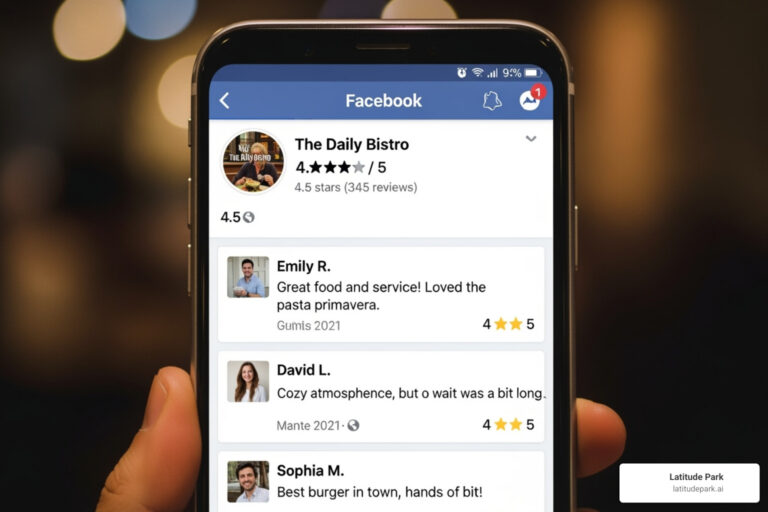In today's competitive marketplace, visibility is everything. For small businesses and franchises, competing against larger corporations can feel like an uphill battle. However, a smart and targeted Search Engine Optimization (SEO) strategy is the great equalizer. It’s not about outspending your competitors; it’s about outsmarting them. This article moves beyond generic advice to provide a comprehensive roundup of actionable SEO tips for small businesses, focusing on on-page, off-page, and crucial local SEO tactics that drive real-world results: more traffic, more leads, and more growth.
Each tip is designed to be practical, with clear examples and implementation steps you can start using today to dominate your local market. While implementing these strategies is crucial for organic growth, some businesses may also consider exploring affordable SEO services tailored for small businesses to accelerate their progress and gain a competitive edge.
From mastering your Google Business Profile to leveraging the power of local content, this guide will provide the tools to turn your online presence into a powerful customer acquisition engine. Let's dive into the strategies that will make a tangible difference.
1. Claim and Optimize Your Google Business Profile
For any small business serving a local community, your Google Business Profile (GBP) is your digital storefront. This free tool from Google is the single most impactful factor for local SEO, allowing your business to appear in the coveted "Map Pack" on Google Search and directly on Google Maps. When a potential customer searches for "pizza near me" or "dentist in [Your City]", a well-optimized GBP is what puts your business front and center.

Neglecting this profile is like having a shop with no sign on the door. It’s a fundamental tool that directly influences customer actions, from getting driving directions to making a phone call. For instance, a local hardware store in Springfield saw a 60% increase in phone calls after simply adding accurate business hours, a comprehensive list of services (like "key cutting" and "paint mixing"), and photos of their in-stock inventory to their profile. This is one of the most direct and high-impact SEO tips for small businesses looking for immediate results.
Actionable Optimization Steps
To turn your profile into a customer-generating machine, focus on providing as much helpful information as possible. Completeness and accuracy are key.
- Select a Specific Category: Don't just list "Restaurant." Choose "Pizzeria," "Italian Restaurant," or "Pizza Delivery" to attract more qualified customers. A practical insight: You can select one primary category and several secondary categories. A cafe that also hosts events should list "Cafe" as primary and "Event Venue" as secondary.
- Upload High-Quality Photos: Showcase your storefront, products, team, and happy customers. Aim for at least 10 high-resolution images. Practical insight: Add new photos quarterly to keep your profile looking fresh and active, which Google's algorithm favors.
- Enable Messaging & Respond Quickly: Allow customers to message you directly from your profile and aim to respond within a few hours to show you're attentive. Insight: Google may display your average response time, so quick replies build trust before a customer even contacts you.
- Utilize Google Posts: Regularly share updates, promotions, events, and new product arrivals. Practical example: A boutique can create a post for a "20% off weekend flash sale" with a direct link to the sale items on their website.
- Answer the Q&A Section: Proactively monitor and answer questions asked by the community. You can also pre-populate this section by asking and answering common questions yourself. Example: Ask "Do you offer gift cards?" and answer "Yes, we offer both physical and digital gift cards! You can purchase them in-store or on our website."
For a comprehensive resource on getting the most out of your local listing, consider reviewing an ultimate guide to Google Business Profile optimization.
2. Focus on Long-tail Keywords
Attempting to rank for broad, highly competitive keywords like "lawyer" or "shoes" is an uphill battle for any small business. The solution lies in focusing on long-tail keywords. These are longer, more specific search phrases, typically three to five words or more, that customers use when they are closer to making a purchase or have a very specific need. They are the secret weapon in your arsenal of SEO tips for small businesses.

While these terms have lower search volume individually, their collective traffic can be substantial. More importantly, they have significantly higher conversion rates because they match user intent more precisely. For example, a local bakery has a much better chance of ranking for and converting a customer searching "gluten-free wedding cakes Portland Oregon" than for the generic term "wedding cakes," which is likely dominated by large, national brands. The user searching the long-tail phrase isn't just browsing; they have a specific, urgent need.
Actionable Optimization Steps
Integrating long-tail keywords requires a strategic approach to content creation and on-page SEO. The goal is to become the best answer for these specific queries.
- Find Your Niche Keywords: Use tools like AnswerThePublic or Google's "People Also Ask" section to discover the exact questions your customers are asking. Practical example: If you are a plumber, instead of just "plumber," you might find questions like "how to fix a leaking faucet without a plumber" or "cost to replace a hot water heater in Miami." Creating content around these converts well.
- Create Dedicated Content: Instead of trying to stuff all your keywords onto one page, create dedicated blog posts or service pages that target a specific long-tail keyword. A law firm could create a page specifically for "personal injury lawyer for car accidents in Seattle."
- Analyze Competitor Gaps: Look at what long-tail keywords your direct competitors are ranking for and identify any they might have missed. Practical insight: If a competing roofer has a page for "roof repair," but not for "emergency storm damage roof repair," that's your opportunity.
- Optimize On-Page Elements: Naturally incorporate your chosen long-tail keyword into your page title, headers (H1, H2), meta description, and the body of your content. Insight: Aim for the keyword to appear in the first 100 words and at least one subheading.
- Monitor Search Console: Use Google Search Console to see which long-tail queries you are already getting impressions for. You can often improve your ranking for these terms with a few content optimizations. Example: If you see impressions for "24-hour electrician near me" but don't rank well, add a section to your homepage clarifying your emergency service hours.
For more powerful strategies, explore these 10 keyword research tips that'll help rank your website.
3. Create Location-Based Content
Beyond your GBP, creating content specifically for your service areas is a powerful strategy to dominate local search results. Location-based content involves developing web pages, blog posts, and resources that target the specific towns, cities, or neighborhoods you serve. This approach signals to Google that you are the go-to authority in a particular geographic market, directly answering queries like "plumber in Dallas" or "best coffee shop downtown."

This tactic is essential for any business with a physical location or a defined service area. For example, an HVAC company could create distinct pages for "AC Repair in Plano" and "Furnace Installation in Frisco," each optimized with unique, relevant information. This hyper-local focus not only improves rankings for those specific searches but also builds trust with local customers who see you as an active member of their community. This is one of the most effective SEO tips for small businesses looking to capture high-intent local traffic.
Actionable Optimization Steps
To effectively leverage location-based content, you must go beyond simply listing city names. The goal is to create genuinely valuable resources for each community.
- Build Dedicated "City + Service" Pages: Create a unique page for each core service in each primary location (e.g., "Roof Repair in Austin, TX"). Include details relevant to that area, like common roofing issues caused by local weather. Practical example: On the "Austin" page, mention how you handle issues caused by intense summer heat and hail.
- Write Hyper-Local Blog Posts: Discuss local events, news, or community projects you're involved in. A real estate agent could write neighborhood guides highlighting local schools, parks, and farmers' markets. Example: "Our Top 5 Family-Friendly Activities in the Oak Hill Neighborhood."
- Incorporate Local-Specific Proof: Feature testimonials or case studies from customers in that specific city. For instance, show photos of a completed kitchen remodel in "Arlington, VA" on your Arlington service page. Insight: A video testimonial from a well-known local resident can be incredibly powerful.
- Use Local Schema Markup: Implement
LocalBusinessschema on your location pages to explicitly tell search engines your service areas, addresses, and hours. This provides search engines with unambiguous data about your business location. - Embed Local Maps: Add a Google Map to each location page showing your service radius or office location within that area. This provides a clear visual cue for both users and search engines. Insight: Create a custom map in Google My Maps that highlights key projects or customer locations in that area, then embed it.
To learn more about implementing these technical signals, you can explore this guide on local SEO schema.
4. Optimize for Mobile-First Indexing
In today's world, your customers are more likely to find you on their smartphone than on a desktop computer. Google recognizes this and now uses a "mobile-first" approach, meaning it primarily looks at the mobile version of your website for indexing and ranking. A clunky, slow, or hard-to-navigate mobile site is a direct signal to Google that your user experience is poor, which can severely damage your search visibility.

This is no longer an optional tweak; it's a foundational requirement for modern SEO. For small businesses, where mobile searches often carry immediate local intent ("plumber near me," "cafe open now"), a strong mobile presence is critical. For instance, a local home services company saw a 60% uplift in its mobile conversion rate simply by simplifying its contact forms for smaller screens and making its phone number a "click-to-call" link. This is one of the most vital SEO tips for small businesses aiming to capture on-the-go customers.
Actionable Optimization Steps
Ensuring your site is built for the mobile user first will directly impact your rankings and your bottom line. The goal is to make it effortless for someone on a phone to find information, contact you, or make a purchase.
- Implement Responsive Design: Use a responsive website design that automatically adjusts content to fit any screen size. This is Google's recommended approach over maintaining a separate mobile URL (like m.yourwebsite.com).
- Prioritize Site Speed: Compress images, minify code (CSS, JavaScript), and leverage browser caching. Use Google's PageSpeed Insights to find specific opportunities to speed up your mobile site. Insight: An image that looks great on a desktop can be 3000px wide, but on a mobile screen it's only 400px wide. Serve smaller image sizes to mobile devices.
- Simplify Navigation: Use a "hamburger" menu and keep your navigation structure simple. Mobile users need to find what they're looking for with minimal taps. Practical example: Your mobile menu should have no more than 5-7 top-level items.
- Make Buttons & Links Tappable: Ensure all clickable elements are large enough and have enough space around them to be easily tapped with a finger, avoiding user frustration. Insight: Google recommends a minimum tappable area of 48×48 pixels.
- Check Your Site’s Status: Use Google’s Mobile-Friendly Test tool to get a quick pass-or-fail analysis and identify immediate issues to fix.
5. Build High-Quality Local Citations
Beyond your own website and Google profile, your business's online footprint extends to countless other directories and platforms. These online mentions, known as local citations, are references to your business's name, address, and phone number (NAP). For small businesses, building a portfolio of consistent and accurate citations across the web is a powerful signal to search engines that your business is legitimate and established in its local area.
Citations act as third-party verifications of your business information. Every time a reputable site like Yelp, Angie's List, or an industry-specific directory lists your correct NAP, it reinforces Google's confidence in your location and contact details. This trust directly contributes to higher local search rankings. For example, a plumbing company that methodically built citations in HomeAdvisor, Angie's List, and local chamber of commerce directories saw a 35% increase in qualified leads, as they started ranking for more specific, service-area-based searches.
Actionable Optimization Steps
The goal is quality and consistency over sheer quantity. A handful of accurate listings on high-authority sites is far more valuable than hundreds of incorrect ones on spammy directories.
- Prioritize Foundational Directories: Start with the most important data aggregators and directories. Ensure your NAP information is identical on Google Business Profile, Facebook, Yelp, and Apple Maps.
- Ensure 100% NAP Consistency: This is non-negotiable. "St." versus "Street" or "(555)" versus "555-" can create inconsistencies. Pick one format and use it everywhere. Practical insight: Create a master spreadsheet with the exact NAP, website, and business description to copy and paste from for every new citation.
- Seek Industry-Specific Directories: A law firm should be listed in FindLaw and local bar association directories. A restaurant should focus on TripAdvisor and OpenTable. These niche citations carry more weight. Example: A wedding photographer should prioritize citations on The Knot and WeddingWire.
- Audit and Clean Up Existing Citations: Use tools like Moz Local or BrightLocal to find existing citations. Correct any inaccuracies and identify and remove duplicate listings that can confuse search engines and customers. Insight: Pay close attention to listings for old business locations; these are common sources of confusion.
- Enhance Your Listings: Don't just list your NAP. Where possible, add your business hours, website URL, a detailed business description, and photos to create a richer, more helpful profile.
For a deeper dive into the tools that can streamline this process, you can explore what's offered by local SEO software providers like Whitespark, a company founded by citation-building pioneer Darren Shaw.
6. Optimize Website Loading Speed
In the digital age, patience is a scarce resource. Website loading speed, the time it takes for a page to become fully interactive for a user, is a critical component of both user experience and SEO. Google has officially confirmed that page speed is a ranking factor, and its Core Web Vitals initiative places a heavy emphasis on it. For a small business, a slow website can be a silent killer, driving potential customers away before they even see what you offer.
A fast-loading website directly impacts your bottom line. It leads to better search engine rankings, lower bounce rates, and higher conversion rates. For example, a local e-commerce store that cut its loading time from 8 to just 2 seconds saw a remarkable 40% increase in conversions. This is a powerful demonstration of how performance is one of the most essential SEO tips for small businesses aiming for tangible growth.
Actionable Optimization Steps
Improving your site's speed involves a series of technical checks and adjustments. You can start by running your website through Google's PageSpeed Insights tool to get a baseline report and specific recommendations.
- Compress and Optimize Images: Large image files are the most common cause of slow pages. Use tools like TinyPNG or ImageOptim to compress all images before uploading them to your site. Practical example: A 2MB hero image can often be compressed to under 300KB with no visible loss in quality, saving seconds of load time.
- Choose Fast Web Hosting: Your hosting provider is the foundation of your site's performance. A cheap, shared hosting plan might save money initially but can cost you customers in the long run. Invest in a reliable, fast provider. Insight: Look for providers that offer solid-state drives (SSDs) and server locations close to your target audience.
- Leverage Browser Caching: This technique stores parts of your website, like logos and CSS files, in a visitor's browser. When they return, the site loads much faster because it doesn't have to re-download everything. You can learn more about how to implement browser caching on your site.
- Minimize Plugins and Scripts: Every plugin, widget, or third-party script adds to your site's loading time. Regularly audit your website and remove any non-essential elements that are slowing it down. Insight: Test your site speed, deactivate a plugin, and test again. This can help you identify which plugins are the biggest culprits.
- Use a Content Delivery Network (CDN): A CDN stores copies of your website on servers around the world. It serves your site to visitors from the server closest to them, dramatically reducing load times for a global or national audience. Practical insight: Even for local businesses, a CDN like Cloudflare (which has a free plan) can speed up your site by optimizing image and code delivery.
7. Leverage Customer Reviews and Testimonials
In today's digital marketplace, customer reviews and testimonials are powerful forms of social proof that double as an SEO goldmine. This user-generated content serves multiple critical functions: it provides a continuous stream of fresh, relevant content for search engines, significantly boosts local search rankings, and builds the trust necessary to convert prospects into customers. For small businesses, a strong collection of authentic reviews is often the deciding factor for a customer choosing you over a competitor.
Think of reviews as a direct conversation between your past and future customers. A dental practice with 200+ positive Google reviews, for instance, often ranks higher for local searches and sees a substantial increase in appointment calls compared to a competitor with only a handful. This is one of the most effective SEO tips for small businesses because it directly influences both search engine algorithms and human decision-making, impacting your visibility and your bottom line.
Actionable Optimization Steps
To transform customer feedback into a powerful marketing asset, you need a proactive and systematic approach. Consistency in requesting, managing, and showcasing reviews is crucial for success.
- Systematize Your Requests: Don't just hope for reviews; actively ask for them. Implement a simple follow-up process via email or SMS after a service is completed, providing a direct link to your Google Business Profile. Practical example: A car mechanic can send an automated text 24 hours after service saying, "Hi [Name], thanks for visiting! How was your experience? If we did a great job, could you leave us a review here: [link]?"
- Respond to All Reviews: Engage with every review, both positive and negative. Thank customers for positive feedback and address negative comments professionally and constructively, offering a public solution. Insight: Responding to a negative review well can often win over more future customers than a dozen positive reviews.
- Implement Review Schema: Add review schema markup to your website's service or product pages. This technical step enables Google to display star ratings directly in search results, dramatically increasing click-through rates.
- Showcase Testimonials: Feature your best reviews prominently on your homepage, service pages, and in marketing materials. Use pull quotes and customer photos (with permission) to make them more impactful. Practical example: Embed a live-updating feed of your Google reviews directly onto your website's homepage.
- Encourage Detailed Feedback: When asking for a review, gently encourage customers to mention the specific service they received or the product they purchased. Example: "We'd love to hear what you thought of your new landscape lighting installation!" This adds valuable, keyword-rich content to your online profiles.
For a deeper dive into the importance of this strategy, explore this resource on why great online business ratings will help your company succeed.
8. Create Valuable Local Content Marketing
Beyond just offering a product or service, becoming a trusted local authority is a powerful SEO strategy. Local content marketing achieves this by creating blog posts, articles, and guides that address the specific needs, interests, and questions of your community. This approach establishes your business as the go-to expert, helping you rank for local searches and build genuine relationships with potential customers in your service area.
This strategy works because it answers the questions your local customers are already asking. For example, a pet grooming business that writes about the "Best Dog-Friendly Parks in Austin" directly connects with local pet owners, driving relevant traffic and building brand affinity. This kind of content is not a direct sales pitch; it's a value-add that positions your business as an integral part of the community, making it one of the most effective long-term SEO tips for small businesses.
Actionable Optimization Steps
To transform your website into a hub of local knowledge, focus on creating content that is genuinely useful, relevant, and tied to your geographic location.
- Research Local Questions: Use tools like Google’s "People Also Ask" feature or simply talk to your customers. What are their biggest local challenges related to your industry? An HVAC company could create a guide on "Prepping Your AC for the Texas Summer."
- Highlight Local Events & Landmarks: Write about local community events, sports teams, or festivals. A coffee shop could create a post on "The Best Study Spots Near the University Campus," naturally incorporating local references. Practical example: A bike shop could publish a guide to "The Top 3 Mountain Biking Trails within 20 Miles of Boulder."
- Showcase Local Expertise: Create content that demonstrates your deep understanding of the local market. A real estate agent could publish a monthly "Denver Neighborhood Market Report," establishing themselves as the primary source for local property insights.
- Collaborate with Local Partners: Partner with a non-competing local business on a piece of content. A gym and a health food store could co-author a "Local Guide to a Healthy Lifestyle." Practical Insight: This allows you to tap into each other's audiences when you both promote the content.
- Promote Content Locally: Share your articles in local Facebook groups, community forums, and on your Google Business Profile. This ensures your valuable content reaches the right local audience.
Beyond local content, a strong content marketing strategy incorporates essential content SEO best practices to ensure your valuable information reaches a wider audience.
8 Key SEO Tips Comparison for Small Businesses
| Strategy | Implementation Complexity 🔄 | Resource Requirements ⚡ | Expected Outcomes 📊 | Ideal Use Cases | Key Advantages ⭐💡 |
|---|---|---|---|---|---|
| Claim and Optimize Your Google Business Profile | Medium | Low | Increased local visibility, customer calls | Local businesses targeting local search & mobile | Free to use, builds trust via reviews, direct engagement |
| Focus on Long-tail Keywords | Medium-High | Medium | Higher conversion rates, targeted traffic | Businesses targeting niche or specific search intent | Easier ranking, cost-effective, voice search friendly |
| Create Location-Based Content | High | High | Improved local rankings, community authority | Brick-and-mortar and service-area focused businesses | Builds local authority, attracts qualified local traffic |
| Optimize for Mobile-First Indexing | High | High | Better rankings, improved user experience | Any website prioritizing mobile users | Improved speed & UX, competitive edge on mobile SEO |
| Build High-Quality Local Citations | Medium | Medium | Better local rankings, increased credibility | Small businesses needing citation consistency | Boosts trust & visibility, drives referral traffic |
| Optimize Website Loading Speed | High | Medium-High | Faster load times, higher engagement | E-commerce, local services, mobile-heavy traffic | Better rankings & UX, reduces bounce, boosts conversions |
| Leverage Customer Reviews and Testimonials | Medium | Medium | Higher local ranking, trust building | Businesses relying on reputation & customer trust | Fresh content, social proof, increases CTR |
| Create Valuable Local Content Marketing | High | High | Trusted local authority, qualified leads | Businesses aiming for community engagement | Builds relationships, local engagement, backlink potential |
Putting It All Together: Your Path to SEO Success
The journey through the world of search engine optimization can seem complex, but it's far from insurmountable. By now, you have a comprehensive playbook filled with actionable SEO tips for small businesses designed to deliver tangible results. We've moved beyond generic advice and delved into the specific, high-impact strategies that will propel your business forward in a competitive digital landscape.
From the foundational task of meticulously optimizing your Google Business Profile to the strategic pursuit of long-tail keywords that capture high-intent customers, each tip builds upon the last. You now understand the immense power of creating location-specific content that speaks directly to your community and the non-negotiable importance of a lightning-fast, mobile-friendly website. These elements are not just items on a checklist; they are the interconnected gears of a powerful lead-generation machine.
From Theory to Action: Your Next Steps
The true value of this guide lies not in reading it, but in implementing it. To avoid feeling overwhelmed, focus on a structured approach. Start with the "low-hanging fruit" that offers the quickest returns.
-
Immediate Action Plan (First 30 Days):
- Google Business Profile Audit: Block out two hours this week. Go through every single field in your GBP, update your photos, and create your first three GBP posts.
- Keyword Research: Dedicate time to brainstorm five long-tail keywords relevant to your top service and local area. For example, instead of "plumber," target "emergency plumbing repair for burst pipes in [Your City]."
- Review Generation: Draft a simple email or text message template you can send to your next five happy customers, asking for a review and providing a direct link to your GBP.
-
Long-Term Strategy (Next Quarter):
- Content Creation: Plan one piece of location-based content per month. A "Best Patios in [Your Neighborhood]" guide if you're a restaurant, or a "Winterizing Your Home Checklist" for a local contractor.
- Citation Building: Identify ten high-quality local directories or industry-specific sites and begin the process of building consistent citations.
- Website Speed: Run your site through Google's PageSpeed Insights and share the results with your web developer to address the most critical issues.
Remember, consistency is the secret ingredient to SEO success. A single optimized blog post or a handful of new citations will have a minimal impact. However, a consistent effort over several months will build authority, trust, and, most importantly, a steady stream of organic traffic and qualified leads. Mastering these fundamental SEO tips for small businesses is your direct path to dominating your local market and achieving sustainable growth.
Ready to turn these insights into a dominant online presence but don't have the time to manage it all yourself? The experts at Latitude Park specialize in implementing these exact strategies for small businesses and franchises, handling the technical complexities so you can focus on serving your customers. Visit Latitude Park to learn how we can build a custom SEO plan that drives real, measurable growth for your business.









